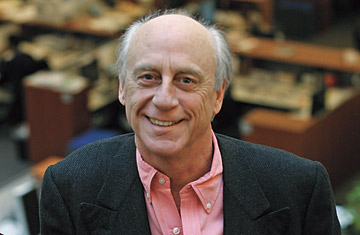
Author and ex-Times man John Darnton
"Dark Days at Newspaper" is a headline that could run on the front page of almost any daily paper in America. Advertising, circulation and relevance are heading downward, and with rounds of layoffs and spending cuts, the cranky, daylight-deprived souls who toil away in newspaper offices are understandably gloomy. The blogosphere churns around the clock with portrayals of newspapers as conservative and out of touch, while feeding like maggots on the content those newspapers provide. Right-wing radio bashes newspapers as too liberal. Far worse than all the criticism is the cold reality that there is simply no stopping the technological and generational shift from print to digital in the news business. The old model — printing news and advertising on large pages of disposable paper — is sinking steadily toward the basement.
So the dark underground caverns of a prestigious New York newspaper are the right setting for the murder at the outset of Black and White and Dead All Over (Knopf; 368 pages) by John Darnton, the author of biology-fiction thrillers Neanderthal and The Darwin Conspiracy. A 30-year veteran of the New York Times, Darnton delivers a knowing, insider's portrait of the newspaper with great sympathy and humor, and successfully captures the intense human drama and daunting business imperatives in the world of newspapering. A sense of impending doom hovers over the enterprise, a sense that its greatness is slipping away.
Black and White is really a novel about the Times (where I once worked as a reporter and foreign correspondent), thinly disguised as a murder mystery. What elevates it to the top of any beach-reading pile is its dead-on depiction of the idiosyncratic life of a big-time newsroom, way more chaotic and disorganized than outsiders can imagine. The adolescent jockeying between ambitious editors, the unpredictable twists of a news-driven day, the rush of deadline pressure, the bickering over how to package incomplete information, the prevalent workaholism and utter abandonment of personal lives, the nightly repairing to a neighborhood bar: These are all elements of an exhausting daily odyssey that yields a remarkably readable, authoritative-sounding version of world events. Newspaper people are romantic and nostalgic about their craft, with its flashes of brilliance and its glaring shortcomings, and with the wry world-weariness that only the brethren can fully appreciate.
The plot of Black and White is engrossing from the get-go. The first murder victim is a much-hated editor who supervised the newspaper's standards of word choice, and who personifies the tyrannical, pretentious side of the Times. (The inside joke here is that the victim, Theodore Ratnoff, is portrayed as a tall and handsome strapping blond, while the real editor of standards, Allan Siegal, was short and heroically rotund.) His body is discovered with a telling item stuck into his chest: a newspaper spike, the symbol of days gone by, when an editor rejecting copy would spike it on a metal spire atop one's desk. The smart-alecky reporter assigned to cover the crime teams up with a dark and attractive (if implausibly aristocratic) female police detective. In their relationship, Darnton skillfully plays with the touchy alliance/competition/mistrust between reporters and cops, mirroring the larger association between the media and government. Surveying the thicket of potential murderers, Darnton can offer a kaleidoscopic view of the characters who populate the newspaper. ("Any suspects?" the editor is asked. He answers: "Let's see. How many people are in editorial? I'd say about twelve hundred.")
The publisher (modeled on the current Times publisher, Arthur Sulzberger) frets about the stock price and drags senior staff to time-wasting group retreats. "Thinking was not his forte, but he had a certain cunning," writes Darnton. The executive editor (modeled on the current executive editor, Bill Keller) is too shy to talk to his staff and constantly reminisces about his days as a foreign correspondent in Russia and Africa. The reporter without a moral compass (Judith Miller, of WMD fame) gets caught plagiarizing Tolstoy. There is even a hard-driving and swashbuckling rival publisher named Lester Moloch (modeled on Rupert Murdoch). There are countless reporters and editors with their own bizarre tics or traits. The murder was clearly a clever inside job. More, I will not give away.
Darnton relies on gentle satire to evoke the many ironies in newspapering and even his seemingly throwaway descriptions of news situations ring utterly true. The ancient pressroom at City Hall looks like "a crowded Mayan ruin littered with the detritus of tourists." The relentless questions rained on a journalist writing a page-one story on deadline is an experience "like getting nibbled to death by ducks."
Darnton, a talented correspondent and editor, excelled at the Times but never won promotion to the highest ranks, allowing him a bitingly accurate perspective on how things really work at the paper. Only now, after his recent retirement, could he write what amounts to a tell-all about the newspaper he clearly loved and gave much of his life to. His novel may lose him a few friends, but it will win him many new admirers.
